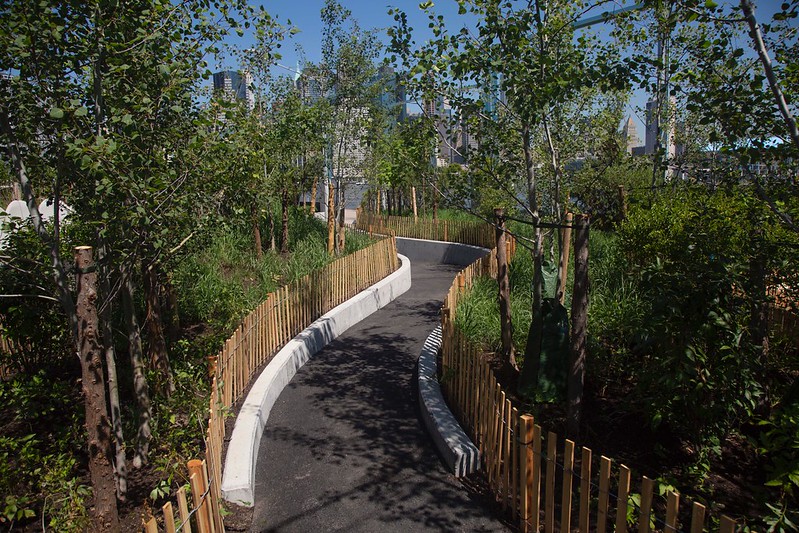
A path to greener pastures (photo: John McCarten/City Council)
As New York City plans for recovery from the COVID-19 pandemic, we must first examine the ways our environmental decisions have contributed to public health abuses in the past and enact a green recovery program that centers the wellbeing of long-ignored communities.
New York City has a long history of environmental racism and injustice. Low-income communities, majority-immigrant communities, and communities of color have borne the burden of severe environmental degradation. Landfills, industrial power plants, waste incinerators and transfer stations, and toxic waste disposal sites are consistently built in lower-income neighborhoods. Data is clear that a person’s zip code is often a greater determinant of health than many genetic predispositions. Yet, due to a lack of political accountability coupled with historically racist zoning and environmental practices, we have repeatedly put the health and wellbeing of fellow New Yorkers at risk.
But we can end this vicious cycle of neglect with effective, comprehensive legislation instead of patchwork solutions.
It’s no secret that the climate crisis is getting worse. But, here in New York, the city’s failure to protect the environment cannot be overstated. Discriminatory city planning initiatives have placed the health of marginalized communities in jeopardy. A lack of access to green energy planning, insufficient neighborhood green spaces, and the effects of toxic waste have led to higher instances of asthma and lead poisoning from Gowanus to Greenpoint.
The scale of contamination in North Brooklyn alone is still being unearthed. Greenpoint, WIlliamsburg, and other parts of the 33rd City Council District are home to multiple federal and state superfund sites and brownfields; and, for decades, residents have felt the massive toxic impacts of these sites in their neighborhoods.. Our communities are also divided by the Brooklyn-Queens Expressway, which has polluted our environment for generations.
Yet, we can still take bold action against these polluters. For years, local environmental advocates have been on the frontlines of neighborhood toxic clean-up and air monitoring initiatives, and have fought tirelessly to hold gas and energy companies accountable for contributing to the district’s disrepair. They need a partner in government.
We must elect legislators who will work with community members to hold toxic polluters accountable, divest from for-profit energy suppliers, and actively work to stop the construction of National Grid’s North Brooklyn Pipeline. Repeatedly, companies like ExxonMobil and National Grid show that they cannot be trusted. We must demand actionable remedies for the harm these companies have caused, and shift to renewable energy. It's time we free ourselves from reliance on fossil fuels. It’s time New Yorkers were in control of their energy — it’s time for public power.
We’ve made progress, but there is still a long way to go toward achieving the green and just New York we need to face the climate crisis head-on.
Foremost, we can commit to creating and expanding a network of open green spaces. This will not only help us meet the challenges of climate change and improve environmental health, but also usher in a new era of safe, efficient, and sustainable transportation in New York. Campaigns like Make Meeker Move and the BQGreen acknowledge the environmental degradation done to Black and Brown communities and seek to take back public space for people.
An investment in open space in neighborhoods that lack parks also creates opportunities for environmental economic growth, and moves us on the urgently needed path away from car-centric infrastructure toward more people-first planning. New protected bike and busways ensure cyclists and pedestrians have safer commuting options; and making the city’s Open Streets program permanent would keep our communities vibrant and help our local businesses thrive in the wake of the COVID-19 pandemic.
In 2012, Hurricane Sandy ripped through our city, causing billions of dollars worth of damage, and lasting harm to residents in public housing. Right now, we are unprepared to handle another hurricane of that magnitude, and our waterfront neighborhoods in Brooklyn need a plan to properly withstand the effects of another deadly storm. We can immediately invest in ‘sponge city infrastructure;’ permeable pavements, green roofs, and cost-effective bioswales in flood prone areas to absorb stormwater and reduce carbon emissions.
Longer-term, we need a comprehensive, citywide resiliency plan and reform of City Environment Quality Review (CEQR) procedures, exploring ways to rezone heavy flood areas as open spaces, create resiliency projects, and increase wetland restoration centers. We also need to build neighborhood energy hubs for storage, and invest in new building energy retrofits. This will create new jobs and we must prioritize communities harmed by environmental racism in hiring.
New York cannot afford to lose more ground in the fight against climate change. These solutions are critical to safeguarding our communities, and will enable us to create a green job corps for COVID recovery.
We must make environmental justice the centerpiece of New York’s economic recovery plan. We need to take an aggressive stance on local and sustainable climate policy, and elect leaders committed to cultivating the future we deserve. It will take work, but we can build this future together.
***
Elizabeth Adams is a Democratic candidate for City Council in District 33, in Brooklyn. Read her full environmental recovery plan here. On Twitter @ElizabAdams.
***
Have an op-ed idea or submission for Gotham Gazette? Email This email address is being protected from spambots. You need JavaScript enabled to view it.




